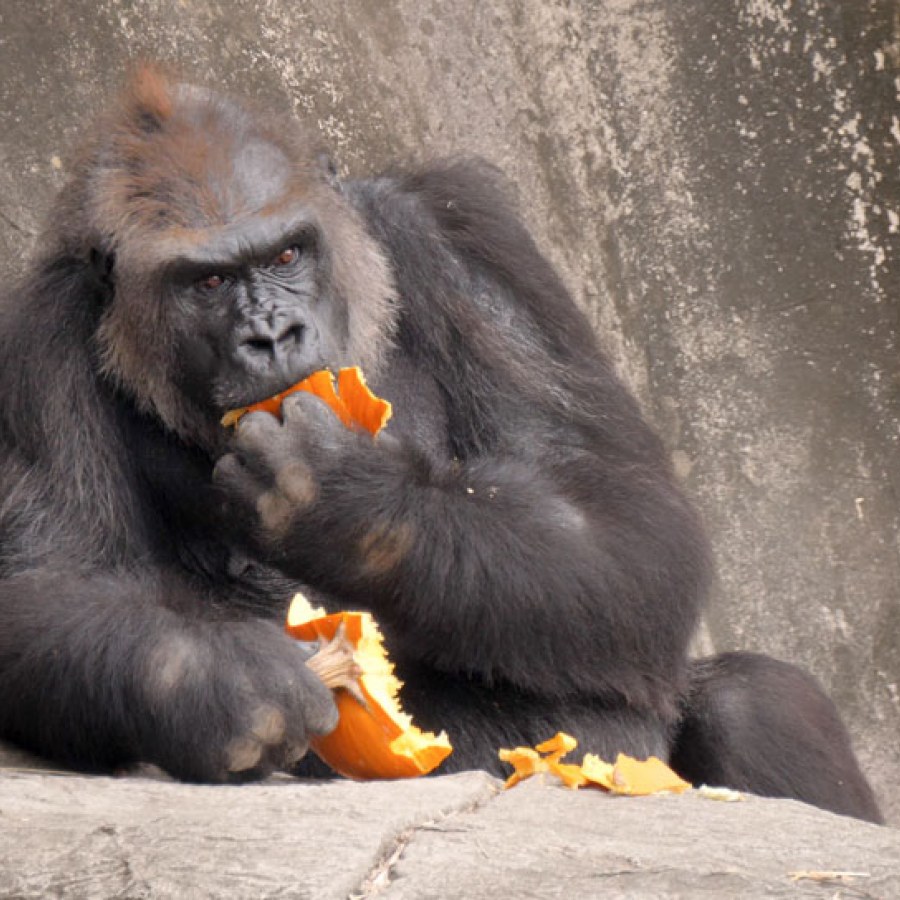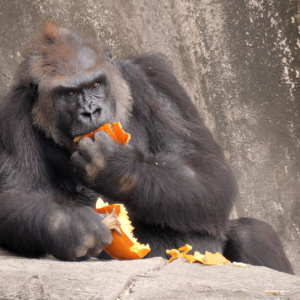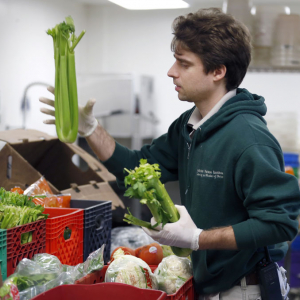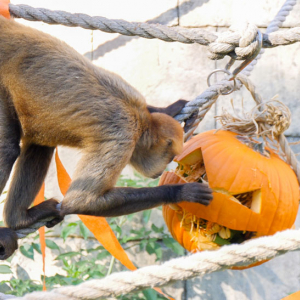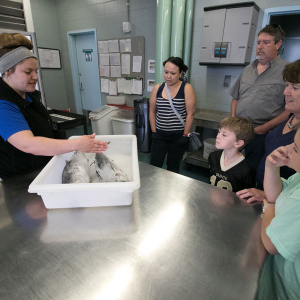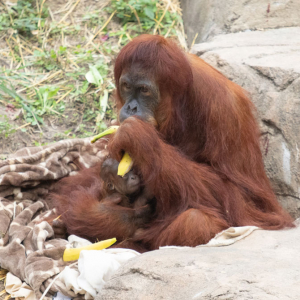In recent years, what to feed your furry friends has been a question on the mind of many pet owners as commercially available options have expanded to include organic and specialized dry kibbles, as well as raw food options found in coolers at your local pet supply store. Some pet owners even choose to prepare home-cooked meals for their pets to have complete control over what their pet eats.
Not many people have time to go as far as preparing fresh custom diets for each of their animals every day, but at Audubon Nature Institute, it’s all in a day’s work. Every Audubon animal has its own custom diet plan tailored to match what their species would eat in the wild, while ensuring that all the individual’s nutritional and medical needs are met. Animal care and veterinary staff monitor the animals’ weights closely and increase or decrease their daily caloric intake as necessary to keep them at their optimal healthy weight.
Audubon Zoo even has a commissary team who works with animal care and veterinary staff to design, prepare and deliver daily meals and food enrichment for the Zoo’s animal residents. Preparing daily meals for Audubon’s animals is a complicated and ongoing process. Meal prep begins the day before, resumes at 6:30 a.m. and continues throughout the entire day. Some of the animals eat multiple times a day, while others, like reptile such as snakes and alligators, may go days or weeks without needing to eat depending on the time of year because of their cold-blooded nature.
On first glance, the zoo commissary kitchen could pass for the kitchen of any local restaurant, with stainless steel prep tables and walk-in coolers filled to the brim with fresh produce, high-grade meats and sustainably harvested seafood. That is, of course, until you notice some of the carnivores’ favorite treats, such as whole frozen mice or blood popsicles.
The Audubon staff prepares restaurant-quality food for thousands of animals daily, resulting in a grocery bill upwards of $70,000 every month. It’s not enough that the animals’ diets are just healthy, but they also need to be tasty. In addition to meeting each animal’s unique nutritional needs, Audubon’s commissary and animal experts need to be almost psychic in discerning shifts in preferences among their clientele. One day the Zoo’s orangutans may favor sweet potatoes, then the next turn their noses up at them in favor of ripe melons.
Knowing the different species and individual animals’ taste preferences also allows staff to use their meals as enrichment tools, introducing novel flavors and textures and delivering the food in ways that challenge the animals to engage in natural behaviors, such as having to climb or dig or use a tool to get at the food. Animal care and commissary staff have fun theming the animals’ enrichment items around holidays, such as offering pumpkins around Halloween, treats in wrapped cardboard boxes around the winter holidays, and rainbow frozen treats for Pride month.
The Zoo isn’t the only place where Audubon staff cook up tasty creations for the animals. If you’ve ever participated in Audubon Aquarium of the Americas’ Backstage Penguin Pass, you would have had an opportunity to see the Aquarium’s kitchen, where animal care staff prepares meals of some of the same raw seafood you might try at a sushi bar.
The Aquarium’s penguin colony love fatty fish like sardines, anchovies and mackerel, while the sea otters love a good crustacean like a clam or mussel. If you pass by the sea otter habitat during mealtime, you can see Ruby and Clara using elements of their habitat, such as the rocky beach and the glass exterior, to help break open the hard shells of their favorite treats—another form of enrichment.
Kristine Grzenda, a curator at Audubon Aquarium of the Americas, says it’s important to pay attention to trends and changes in feeding habits. “Our animals can’t speak to us, so this is how we tell if something is changing for them.” Animals naturally try to hide weakness or illness as a defense against predators. A change in eating habits may be a sign that something is wrong, or it may be something as simple as a personal preference. “As professionals, it’s our job to be on the lookout for these changes to interpret what they mean,” added Grzenda.
Audubon’s insects, on the other hand, have some dietary preferences that you would not find in a local restaurant kitchen. The monarch caterpillars munch on milkweed leaves before transforming into butterflies, a tarantula can spend hours sucking on a juicy moth, the predacious beetles feast on blood worms and the dung beetles enjoy well … poop. But not just any poop! The dung beetles are fed only dung collected from cows that haven’t been given worming agents, requiring careful coordination with local farmers. It is then frozen before being thawed and fed to the beetles on what the entomology staff dubbed “Poos-day.”
Feeding the animals of Audubon presents such an interesting challenge. Last year Commander’s Palace Executive Chef Meg Bickford got in on the fun, preparing a holiday Reveillon feast for some of the zoo’s culinary critics, including orangutans, Asian small-clawed otters, babirusas, Asian elephants and a Malayan sun bear. The menu included: peanut butter banana pineapple oat muffins, crispy sunflower, pumpkin and apple biscuits, and pistachio and cardamom sweet potato bars. As part of their support of Audubon’s Feed the Animals campaign last year, Rouses Markets generously donated some of the items that Chef Bickford used to prepare the spread. Keep an eye on Audubon’s social media this fall to see what other fun enrichment opportunities the Audubon team cooks up for the holidays.
You can support wildlife like the animals you visit at the zoo and aquarium by taking a page from their dietary book and keeping the natural world in mind when doing your own grocery shopping. Buy from local growers when you can, choose produce grown without toxic pesticides, purchase candy made with sustainable palm oil, look for coffee with the Smithsonian’s Bird Friendly logo, and download the Audubon G.U.L.F. program’s Gulf Seafood Guide mobile app to help you select fresh, sustainably harvested seafood whether you’re dining out or shopping to cook at home.
Additionally, you can support the Audubon animals donating to the Audubon Recovery Fund. Your tax-deductible year-end donation to the Audubon Recovery Fund will ensure that the 15,000 animals in Audubon’s care continue receiving high-quality care and nutritious, engaging meals all year. Donate today at www.AudubonRecoveryFund.com.
Not many people have time to go as far as preparing fresh custom diets for each of their animals every day, but at Audubon Nature Institute, it’s all in a day’s work. Every Audubon animal has its own custom diet plan tailored to match what their species would eat in the wild, while ensuring that all the individual’s nutritional and medical needs are met. Animal care and veterinary staff monitor the animals’ weights closely and increase or decrease their daily caloric intake as necessary to keep them at their optimal healthy weight.
Audubon Zoo even has a commissary team who works with animal care and veterinary staff to design, prepare and deliver daily meals and food enrichment for the Zoo’s animal residents. Preparing daily meals for Audubon’s animals is a complicated and ongoing process. Meal prep begins the day before, resumes at 6:30 a.m. and continues throughout the entire day. Some of the animals eat multiple times a day, while others, like reptile such as snakes and alligators, may go days or weeks without needing to eat depending on the time of year because of their cold-blooded nature.
On first glance, the zoo commissary kitchen could pass for the kitchen of any local restaurant, with stainless steel prep tables and walk-in coolers filled to the brim with fresh produce, high-grade meats and sustainably harvested seafood. That is, of course, until you notice some of the carnivores’ favorite treats, such as whole frozen mice or blood popsicles.
The Audubon staff prepares restaurant-quality food for thousands of animals daily, resulting in a grocery bill upwards of $70,000 every month. It’s not enough that the animals’ diets are just healthy, but they also need to be tasty. In addition to meeting each animal’s unique nutritional needs, Audubon’s commissary and animal experts need to be almost psychic in discerning shifts in preferences among their clientele. One day the Zoo’s orangutans may favor sweet potatoes, then the next turn their noses up at them in favor of ripe melons.
Knowing the different species and individual animals’ taste preferences also allows staff to use their meals as enrichment tools, introducing novel flavors and textures and delivering the food in ways that challenge the animals to engage in natural behaviors, such as having to climb or dig or use a tool to get at the food. Animal care and commissary staff have fun theming the animals’ enrichment items around holidays, such as offering pumpkins around Halloween, treats in wrapped cardboard boxes around the winter holidays, and rainbow frozen treats for Pride month.
The Zoo isn’t the only place where Audubon staff cook up tasty creations for the animals. If you’ve ever participated in Audubon Aquarium of the Americas’ Backstage Penguin Pass, you would have had an opportunity to see the Aquarium’s kitchen, where animal care staff prepares meals of some of the same raw seafood you might try at a sushi bar.
The Aquarium’s penguin colony love fatty fish like sardines, anchovies and mackerel, while the sea otters love a good crustacean like a clam or mussel. If you pass by the sea otter habitat during mealtime, you can see Ruby and Clara using elements of their habitat, such as the rocky beach and the glass exterior, to help break open the hard shells of their favorite treats—another form of enrichment.
Kristine Grzenda, a curator at Audubon Aquarium of the Americas, says it’s important to pay attention to trends and changes in feeding habits. “Our animals can’t speak to us, so this is how we tell if something is changing for them.” Animals naturally try to hide weakness or illness as a defense against predators. A change in eating habits may be a sign that something is wrong, or it may be something as simple as a personal preference. “As professionals, it’s our job to be on the lookout for these changes to interpret what they mean,” added Grzenda.
Audubon’s insects, on the other hand, have some dietary preferences that you would not find in a local restaurant kitchen. The monarch caterpillars munch on milkweed leaves before transforming into butterflies, a tarantula can spend hours sucking on a juicy moth, the predacious beetles feast on blood worms and the dung beetles enjoy well … poop. But not just any poop! The dung beetles are fed only dung collected from cows that haven’t been given worming agents, requiring careful coordination with local farmers. It is then frozen before being thawed and fed to the beetles on what the entomology staff dubbed “Poos-day.”
Feeding the animals of Audubon presents such an interesting challenge. Last year Commander’s Palace Executive Chef Meg Bickford got in on the fun, preparing a holiday Reveillon feast for some of the zoo’s culinary critics, including orangutans, Asian small-clawed otters, babirusas, Asian elephants and a Malayan sun bear. The menu included: peanut butter banana pineapple oat muffins, crispy sunflower, pumpkin and apple biscuits, and pistachio and cardamom sweet potato bars. As part of their support of Audubon’s Feed the Animals campaign last year, Rouses Markets generously donated some of the items that Chef Bickford used to prepare the spread. Keep an eye on Audubon’s social media this fall to see what other fun enrichment opportunities the Audubon team cooks up for the holidays.
You can support wildlife like the animals you visit at the zoo and aquarium by taking a page from their dietary book and keeping the natural world in mind when doing your own grocery shopping. Buy from local growers when you can, choose produce grown without toxic pesticides, purchase candy made with sustainable palm oil, look for coffee with the Smithsonian’s Bird Friendly logo, and download the Audubon G.U.L.F. program’s Gulf Seafood Guide mobile app to help you select fresh, sustainably harvested seafood whether you’re dining out or shopping to cook at home.
Additionally, you can support the Audubon animals donating to the Audubon Recovery Fund. Your tax-deductible year-end donation to the Audubon Recovery Fund will ensure that the 15,000 animals in Audubon’s care continue receiving high-quality care and nutritious, engaging meals all year. Donate today at www.AudubonRecoveryFund.com.
Tagged in Zoo Dat in our Winter 2021 issue
